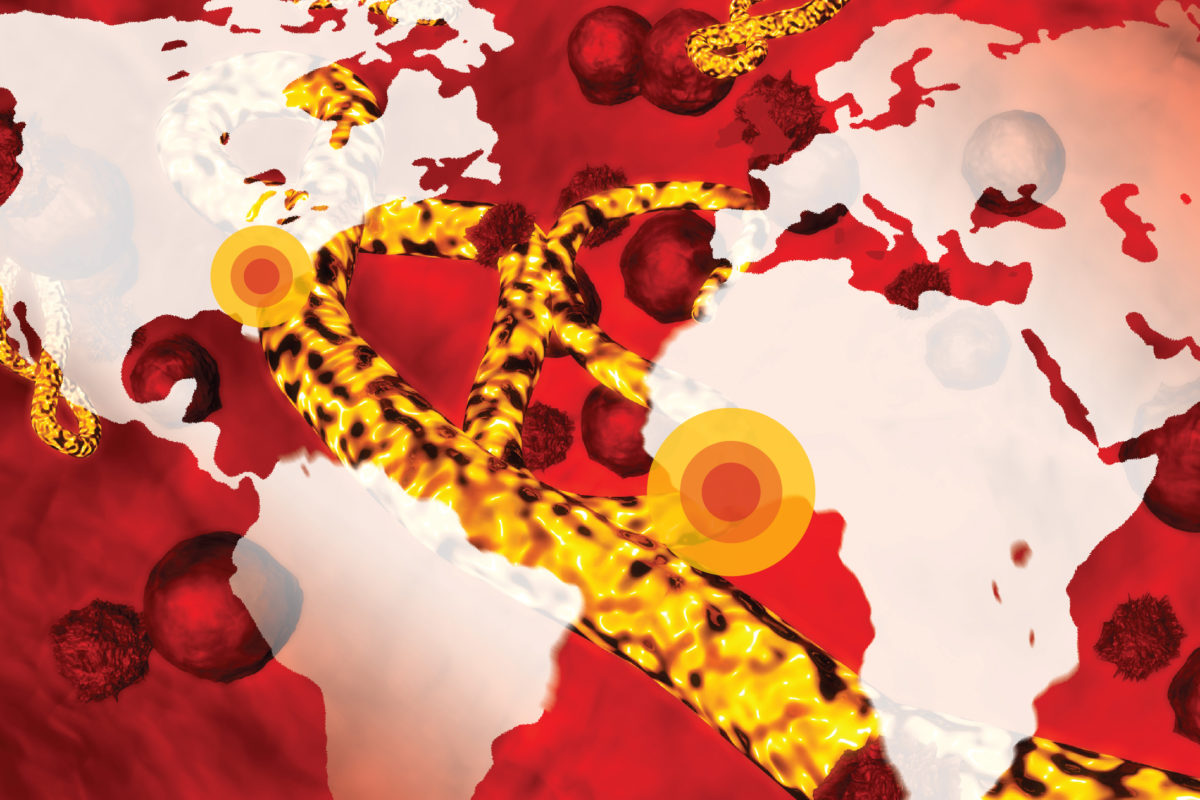As a steady snow fell on April 9, a woman who had recently traveled to West Africa arrived at the Middletown Emergency Department with fever, nausea, vomiting and diarrhea.
All are symptoms of the Ebola virus.
Triage Nurse Linda Biggs, R.N., recognized a potentially life-threatening situation. She asked the patient to return outside and use a private, protected entrance to a decontamination room so she would not infect other patients and Emergency Department staff.
Quickly, attending physician Gordon Reed, M.D., donned personal protective equipment to examine the patient, and a leader of the Ebola Response Team — Chris Rogan, M.D., chair of the Emergency Management Committee — drove to the Middletown Emergency Department, as did Erin E. Watson, M.D., FACEP, medical director of the Middletown Emergency Department, and other staff.
“I was concerned when I first learned from texts and phone calls that we might have a patient with Ebola,” said Dr. Watson. “But Chris Rogan is an expert in this area, and our staff trained for this scenario. There was no hysteria, only professionals working in a great atmosphere of cooperation.”

Marci Drees, M.D., MS, FACP, DTMH, infection prevention officer and hospital epidemiologist, who also plays a leading role on the Ebola Response Team, said Liberia had recently reported new Ebola cases, and the risk in Middletown was real. “The patient had very specific symptoms, so we needed to rule out Ebola before we could feel safe doing everything else we could for her,” Dr. Drees said.
Since the U.S. Ebola alert of 2014, this was the first time protocols established to deal with the highly infectious threat were implemented by Christiana Care, though the Ebola Response Team and subgroups within the Emergency Management Committee have devoted considerable resources and planning to be ready, said Ken Silverstein, M.D., MBA, chief clinical officer. As a result of these steps, Christiana Care will be designated the official Ebola Assessment Center for the state of Delaware.
“From the beginning the Emergency Management Committee has focused on how to assess the Ebola threat and develop a program to protect patients, staff and the wider community,” said Dr. Rogan, who expressed gratitude to committee members who worked on the Ebola Preparedness Plan, including Emergency Management Committee Vice Chair Kathryn Groner, M.D., and hospitalist Erin M. Meyer, D.O., FAWM, FAAP, FACP, SFHM.
The Ebola Response Team includes members from Infection Prevention, the Emergency Department, Emergency Management, Infectious Disease, Obstetrics, Nursing, Laboratory, Security, Environmental Services, Pharmacy, External Affairs, Interpretive Services and Purchasing.
An early team priority was to set up a special isolation unit for patients with emerging pathogens in a restricted area at Wilmington Hospital. The unit is a self-contained treatment area and command center with computer-supported oversight of two patient rooms, an on-site laboratory, radiology services, and designated areas for donning and removing personal protective equipment.
Here, nurses, doctors and other staff train in the proper use of personal protective equipment — yellow suits and white hoods made of a special protective material. In simulations, staff members learn to use precise, careful motions to prevent exposure in navigating the special isolation unit.
“A person with ebola can lose fluids rapidly from vomiting and diarrhea. The risk of disease exposure to these fluids is high,” said Kathleen Wroten, MSN, RN, CIC, director of Infection Prevention. “This is why we have to protect ourselves by wearing special suits, three sets of gloves and special respiratory protection equipment.”
Despite an air-purifying respirator that provides some cooling to the upper body, the protective suits can become quite warm. Staff try to limit work in the suits to three hours at a time.
One safety communication aid is “Robby,” a robotic iPad that stands belt-high on two wheels and is capable of roaming the “hot zone” of a patient’s room. “This gives the command center a look inside a room and is an added measure of precaution, showing how the nurses are doing and ensuring that they are not becoming soiled with contaminants,” Wroten said.
On the morning of April 9, Dr. Drees had a central role in activating the Ebola plan. This entailed conference calls involving Delaware Division of Public Health (DPH), the Centers for Disease Control and Prevention (CDC) and scores of Christiana Care staff.
The DPH is charged with planning and coordinating management of any ebola or any high-consequence infectious-related response in Delaware. DPH has worked with Christiana Care and other partners to develop a statewide plan to care for such patients in the event of a case or larger outbreak. This includes patient transportation, sample testing, communications, fatality response and larger community response in the event of an actual emergency.
Once the plan was activated, a cadre of Ebola Response Team members arrived at the special isolation unit, including infection prevenionists Lorraine Adkins, BSN, RN, CIC, Nora Protokowicz, MSN, RN, NE-BC, CIC, and Paula Fasano, MSN, RN. They were there to make sure all equipment was in place and to ensure coordination of the patient transport team in moving the patient on a stretcher topped with a special isolation containment unit.
Critical care nurse Kathy Crawford, MSN, RN, CCRN, served as nurse staffing coordinator on the special isolation unit, making sure there were enough trained nurses to care for the patient, as well as replacement nurses to fill in for those pulled from hospital shifts. She also monitored clinical staff in the correct use of personal protective equipment.
The first team of nurses who attended to the patient — Kate Armstrong, BSN, RN, CCRN, and Ashley Gallagher, BSN, RN, CCRN, FNP-C — arrived before
1 p.m. and had their vital signs checked to ensure they were well enough to proceed.
Gallagher’s adrenalin was pumping as she washed up, took off her jewelry and put her hair up so she could wear a protective mask. She and Armstrong reviewed the procedure for how to gown. They were carefully walked through the process of getting dressed in their personal protective equipment.
“Others watched to make sure there were no tears and rips,” Gallagher said.
By early afternoon the ambulance transport arrived at Wilmington Hospital from Middletown, and the transport team moved the patient safely to her room according to procedure. Armstrong and Gallagher had a decision to make.
“In attending to a patient, one nurse can sit outside the room and the other can go in, or you both can go in,” said Gallagher. “Kate and I felt strongly about us both going in. I knew there would always be someone there to help.”
Once inside, they moved deliberately. Gallagher felt her awareness sharpen as she ran through protocols she had rehearsed and drew the first blood sample. Watching from a monitor at the command center was a group of team members.
“We kept a close eye on the nurses,” said Protokowicz, who served as the site manager. “This was a situation where a great deal of talent, knowledge and experience came together to protect our health care workers and the community.”
With so many precautions, Gallagher felt safe.
“I had done this before in simulations and knew that if anything should happen there were checklists, people and other safety measures in place so there would be a positive result,” she said.
Other nurses who volunteered to be part of the Ebola Response Team and were present that day included Theresa Deamond, BSN, RN, Charles Evans, BSN, RN, Linda Roderick, BSN, RN, CCRN-CMC, Lew Klensch, BSN, RN, CCRN, and Desiree T. Hodges, MSN, RN, CCRN.
An early focus of nursing efforts was to soothe the patient’s nausea.
While the likelihood of Ebola was extremely small, blood testing was recommended out of caution. A blood sample was sent via state transport to the DPH lab in Smyrna to test for Ebola. By 11 p.m., they learned that the patient tested positive for malaria, not ebola, and isolation was discontinued. The patient was transferred to another room within Wilmington Hospital.
“It was incredibly impressive to see all the team members snap into action and to see the patient brought by a transport team to Wilmington Hospital on that snowy spring Saturday,” said Mike Eppehimer, MHSA, FACHE, senior vice president, service line operations. “Once at Wilmington, the patient continued to receive an accomplished level of care that began in Middletown.”
Dr. Drees said everything worked well, thanks to numerous simulations and drills held over the past two years. These involved the DPH, Dover Air Force Base, the CDC and numerous staff from Christiana Care. Had the patient tested positive for Ebola, she would have remained on the special isolation unit for no more than 96 hours, before being transported to Johns Hopkins Hospital in Baltimore, a regional treatment center for Ebola.
Throughout the episode, Christiana Care employees demonstrated the ability to efficiently manage a serious threat of Ebola in consultation with the Division of Public Health and the CDC.
“This is what we are trained and prepared to do in serving our neighbors as expert, caring partners in their health,” said Janice E. Nevin, M.D., MPH, president and CEO, in a thank-you message to the staff. “I especially want to thank the staff at the Middletown Emergency Department, the transport team and those at the Wilmington Campus for their efforts in providing expert, compassionate care.”
Those sentiments were echoed by Karyl Rattay, M.D., MS, director of the DPH. “DPH is grateful to Christiana Care for their management of this situation and patient,” Dr. Rattay said. “From the initial call on Saturday morning to the negative blood test on Saturday night, Christiana Care staff worked in strong partnership with DPH. Management of any potential emergency health situation depends entirely on the plans and players involved. Christiana Care rose to that challenge and deserves enormous credit for their work to protect the patient, their staff and the public.”
While Ebola is unique in some aspects, it is similar in many ways to a wide variety of infectious diseases. Ebola preparations have helped Christiana Care to raise its overall level of preparedness for diseases such as Middle East respiratory syndrome (MERS), the Zika virus and other pathogenic infections.
“A lot of what we learned from Ebola can be applied to other emerging diseases,” said Dr. Drees. “For instance, Zika is an infection that seems to have to come out of nowhere, even though it had been isolated in the 1940s. As frontline providers, we now have a global view of health and know that the best way to be ready to offer the highest quality care is to have our protocols in place.”



